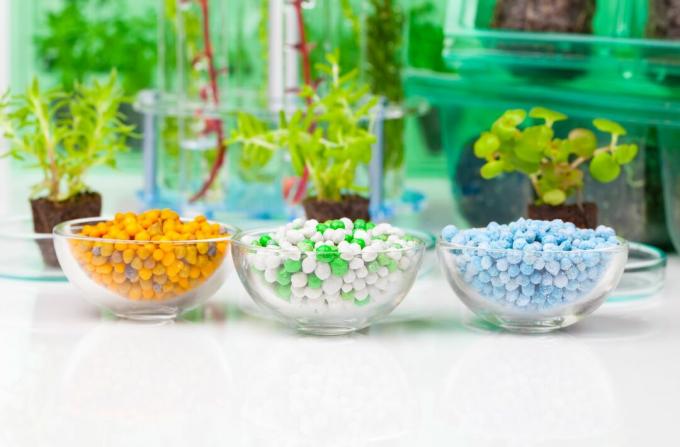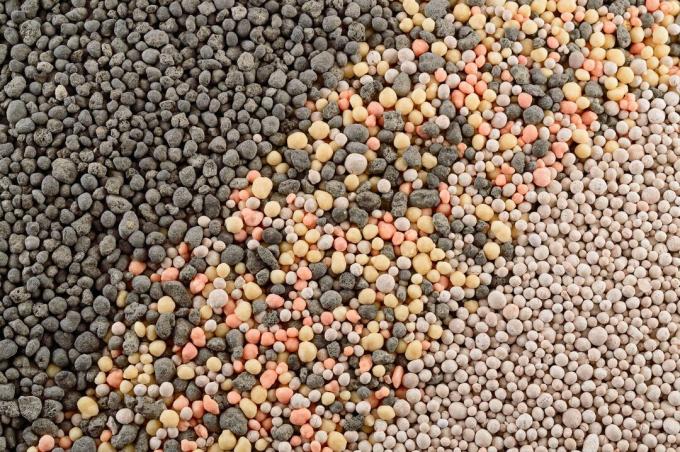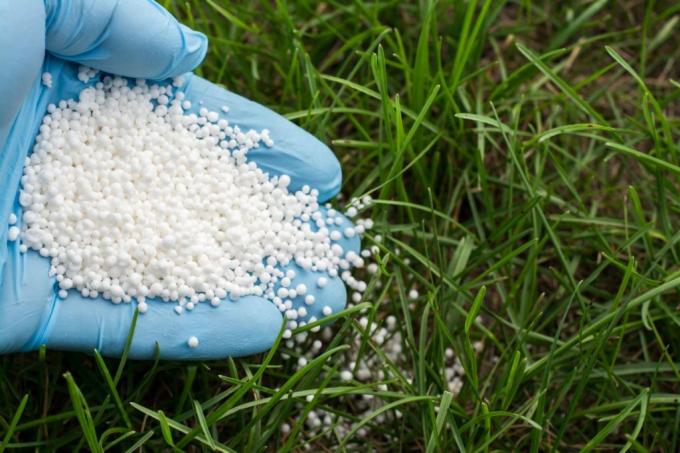Mineral fertilizers are obtained using synthetic processes or from fossil minerals. We take a closer look at these "artificial fertilizers".

Already in 1865 Justus von Liebig recognized after intensive research: “A soil is fertile for a given plant genus, if he has the mineral nutrients necessary for this plant in the right amount, in the right proportion and in the right amount In this way, he initiated a development that very soon led to the production of the first mineral fertilizers led. More than a century later, however, the mineral fertilizer has already passed the zenith of its popularity and has not only come under fire in organic farming. In this article we have compiled the properties, advantages and disadvantages, examples and the dangers of mineral fertilizers for you.
contents
-
Mineral fertilizer: properties
- What is mineral fertilizer?
- Manufacture of mineral fertilizers
- Effect of mineral fertilizers
- How quickly does mineral fertilizer work?
- Mineral-organic fertilizer
-
Mineral fertilizer: advantages and disadvantages
- Mineral fertilizer vs. organic fertilizer
-
Mineral fertilizer: examples
- Mineral nitrogen fertilizer
- Mineral NPK fertilizer
- Blue grain
- Mineral fertilizer: toxic and dangerous?
Mineral fertilizer: properties
For a long time, mineral fertilizers were used as a potent wonder drug. Here you can read about what constitutes mineral fertilizers.
What is mineral fertilizer?
Mineral fertilizer is a fertilizer in which the nutrients - or rather, the nutrient ions - are present in a solid "ionic compound". Perhaps you are more familiar with the term “salt”. Table salt, for example, is the ionic compound of sodium (Na+) and chlorine (Cl–) represent. Due to the attraction of the positive and the negative charge, the two charged particles - the ions - form a firm bond. And mineral fertilizers are found in precisely such a connection. It is not for nothing that one often speaks of “fertilizer salts”.
Manufacture of mineral fertilizers
But how are these mineral fertilizers made? Many nutrients can be extracted from fossil deposits. However, they exist in the rock as a stable, hardly soluble compound. However, plants only absorb nutrients in the form of ions dissolved in water. For this reason, rock phosphates, for example, have to be "unlocked". This is done with acids and leads to more soluble phosphate compounds, the superphosphates. Potash salts are also prepared before use as fertilizer and are then called 40, 50 or 60 potash, the number indicating the percentage of water-soluble potassium oxide contained. Or they are converted into sulfuric acid potash with sulfuric acid.

Mineral nitrogen is produced using the "Haber-Bosch process". With great energy expenditure, the atmospheric nitrogen (N2) the volatile ammonia (NH3). This can be converted into the common fertilizers ammonium nitrate, ammonium sulfate (called: sulfuric acid ammonia) or potassium nitrate.
Since various complex chemical processes are used in the production of mineral fertilizers, they are also referred to as "artificial fertilizers". So now the fertilizer is in its salt form. It contains salts that are formed from the essential nutrient elements of the plants. But what effect do they have when they are scattered into the ground?
Effect of mineral fertilizers
If the soil is moist, the salts dissolve into their ionic components. From a chemical point of view, water plays the decisive role here: It attaches to both positively charged and negatively charged particles. Real shells of water are formed around them. This is how the water separates the components of the fertilizer salt from one another. One speaks of "hydration". Some salts - various phosphorus compounds and many trace nutrients - can only be dissolved by acids. But these also occur naturally in the soil solution. After this step, the nutrients are available to the plant and can be absorbed and used.
Note: Plants only take up nutrients as ions? Actually, that's not entirely true. The nutrient element boron is in the neutral form B (OH)3 (Boric acid) added. However, this represents a special case. Boron is involved in the formation of cell walls and promotes the formation of flowers and fruits.
Summary: what is mineral fertilizer?
- Mineral fertilizer is in the form of salt. Salts consist of positively and negatively charged particles - the ions. These are connected by the ionic bond
- The raw materials for mineral fertilizers are extracted from fossil deposits or - in the case of nitrogen - produced using the Haber-Bosch process. All of these still have to be chemically converted. Overall, the energy required for this is very high
- The chemically modified raw materials are more soluble in water or in the soil's own acids and are in their ionic form after they have been dissolved in the soil. So they can be absorbed by plants

How quickly does mineral fertilizer work?
In general, a normal mineral fertilizer in salt form can work very quickly: usually within a few hours. Of course, this does not apply to slow release fertilizers, the slow release of which is an intentionally induced effect. Several factors influence whether a mineral fertilizer works quickly or slowly according to its mode of action. We have listed these factors for you below. By observing them, you can achieve the fastest possible effectiveness of your fertilization.
Tip: An effect in the sense of a visible fertilizing effect on the fertilized plants always takes some time. Even with fast-acting liquid fertilizers, you have to wait a few days for a visible effect.
When the effective speed is spoken of in the following paragraph, it is the speed meant in which the plant-available nutrients in the soil solution after the application of the fertilizer are present.
- Water is essential for the solution of the salts. Therefore, the soil must be sufficiently moist. Mineral (and organic) fertilizers have no effect on dry soil.
- Interactions that occur between fertilizer salts can influence their effects:
- Ammonium-containing fertilizers and lime or calcareous fertilizers together form ammonia, which leaves the soil in gaseous form and is therefore no longer usable for plants
- Superphosphate and lime or calcareous fertilizers together form calcium phosphates, which are difficult to dissolve and only very slowly (or not at all) available to plants
- Nitrate or fertilizers containing nitrates and superphosphate together form nitrogen oxides (NOx), which escape from the soil in gaseous form and are therefore no longer usable for plants. They are also extremely harmful to health and the climate

Tip: All mixed compound fertilizers available on the market never contain the above combinations and are safe to use. There is therefore no risk of outgassing or retention. However, if you want to mix different fertilizers yourself, please note the problem cases mentioned above.
- The pH value of the soil also has an influence on the speed of action of mineral fertilizers. In particular, trace elements are more readily available in slightly acidic soil. In a neutral or slightly alkaline soil, fertilizing with them has a significantly worse effect. The situation is even more extreme with phosphorus: it is not readily available at a pH value below 6 or above 6.5. Keeping your own garden soil in this area can therefore have a very positive effect on the fertilizing effect.
- The temperature plays a certain role: at higher temperatures the fertilizer salts are more soluble in the soil solution. In addition, at higher temperatures plants draw more water from the soil and thus “suck” many nutrients to their roots.
Long-term fertilizers are a special case: These fertilizers work particularly slowly and over long periods of time - between two months and a year, depending on the product. This effect is achieved because the nitrogen it contains is in a special form called urea or carbamide. In addition, the nutrients are encased in a capsule that protects them from being released immediately into the soil solution. By adding immediately soluble fertilizer salts, an additional effect is often achieved.
Summary: How quickly does mineral fertilizer work?
- Mineral fertilizers take effect within a few hours of application if the conditions are right. Depending on the plant and nutritional status, visible effects will of course only occur much later
- The availability of water, the combination of fertilizers applied, the pH value of the soil and the temperature can have a positive or negative effect on the speed of action
- Long-term or depot fertilizers work over a long period of time and, under certain circumstances, a little more slowly. However, many slow-release fertilizers also have an immediate effect. The duration of action can be up to 12 months and is indicated on the packaging
Mineral-organic fertilizer
What is a mineral-organic fertilizer and how does this type of fertilizer differ from purely mineral fertilizers? Mineral-organic fertilizers contain both organic and mineral components.

The combination of the two types of fertilizer only seems logical, because their advantages and disadvantages often balance each other out:
- Purely mineral fertilization neglects soil life and the maintenance of a good soil structure. Organic fertilization helps to maintain and promote both
- Organic fertilizer is available slowly, whereas mineral fertilizer is available quickly
- Mineral fertilizers always only contain the nutrients mentioned. Organic fertilizer also always contains a small amount of trace nutrients that are contained in the organic material
- Mineral fertilizers do not have a pronounced long-term effect unless they are special long-term fertilizers. Organic fertilizers have a natural long-term effect, so that the two types can easily be combined to form a fast-acting long-term fertilizer
- Purely mineral fertilizers run the risk of being washed out if no organic material is incorporated into the fertilization. The organic content in the mineral-organic fertilizer can prevent leaching, at least to a certain extent
Summary: Mineral-organic fertilizer
- Mineral-organic fertilizer contains both mineral and organic components
- These components can complement each other in terms of their properties in terms of soil improvement, speed of action, ingredients, duration of action and risk of leaching
- The result can be a fertilizer with few disadvantages and many good properties
Mineral fertilizer: advantages and disadvantages
Some only see the good, others only the bad in mineral fertilization. We have tried to objectively summarize the advantages and disadvantages.
Advantages of mineral fertilizers:
- Fast acting speed
- Often low price (except long-term fertilizers)
- High levels of nutrients
- As a long-term fertilizer, it is very safe to use and effective over a very precisely defined period of time
- The release of nutrients is largely independent of the weather, so that mineral fertilizers can be used in a more targeted and short-term manner

Disadvantages of mineral fertilizers:
- Mineral fertilizers bypass the natural cycle of nutrient recycling. This can lead to a chemical imbalance in the soil, which is reflected in a changed pH value
- Mineral phosphate fertilizers often contain the heavy metal cadmium, which even in very small amounts is not only very toxic but also causes cancer
- The rapid and weather-independent release and the high nutrient content lead more easily to plant damage through over-fertilization and to a loss of nutrients through leaching
- Mineral fertilization alone causes the soil to become depleted of humus over time, which results in a significant deterioration in many soil properties. If you are more interested in humus and humus formation, you will find the articles on humus and humus management here
- The needs-based fertilization with mineral fertilizers basically requires prior knowledge in the field of plant nutrition and soil chemistry for correct application
Tip: Did you know, for example, that phosphorus fertilization is not even necessary on almost all garden soils, as phosphorus is available in sufficient quantities? Often it has become poorly soluble due to improper fertilization in combination with lime, or it is not available due to a pH value that is too high or too low.
Mineral fertilizer vs. organic fertilizer
We recommend that you use organic or organic-mineral fertilizers such as ours, especially because application errors occur much more frequently with mineral fertilizers Plantura fertilizers. The following table compares the aspects of organic and mineral fertilization again.
| Aspects | Mineral fertilization | Organic fertilization |
|---|---|---|
| Effective speed | Fast | Slow |
| Nutrient release | Concentrated | Slowly flowing |
| Nutritional content | Medium to high | Low to medium |
| Promotion of soil life | no | Yes |
| Preservation / improvement of the soil structure | no | Yes |
| Application security | Small amount | High |
| Risk of washout | High | Little to no |
| Influence on the pH value | Depending on the fertilizer used | no |
| Release depending on the weather | no | Yes |
Mineral fertilizer: examples
What mineral fertilizers are there? In this section you will find examples and explanations of different types of mineral fertilizers.
Mineral nitrogen fertilizer
Mineral nitrogen fertilizers are available in various chemical compounds. According to their name, they only contain nitrogen and one other element with which they form a salt - so they are not a balanced full or NPK fertilizer. Depending on the element with which the salt is formed, they also have different properties.

Sulfuric acid ammonia: It contains ammonium nitrogen and sulfur, is easily soluble in water and acts moderately quickly because ammonium is bound to soil particles. For this reason, the risk of leaching is lower. Sulfuric ammonia is acidic and therefore also lowers the pH of the soil. The duration of action is three to four weeks.
Calcium nitrate: It contains nitrate-nitrogen and calcium, is easily soluble in water and has a fast acting speed. Calcium nitrate is alkaline and thus increases the pH value of the soil. Its duration of action is three to four weeks.
Calcium ammonium nitrate: It contains ammonium nitrogen and nitrate nitrogen, plus calcium and sometimes magnesium. It is also readily water-soluble and, thanks to the two nitrogen compounds it contains, has both a fast and long-lasting effect. The combination also does not affect the pH value. The duration of action is three to four weeks.
Ammonium sulfate nitrate: It contains ammonium nitrogen and nitrate nitrogen in combination with sulfur, is easily soluble in water, has a fast and lasting effect. Ammonium sulphate nitrate is acidic and lowers the pH of the soil.
urea: Fertilizer urea or carbamide nitrogen has no other secondary components. Although it is produced artificially, it has to be converted microbially into ammonium that is available to plants in the soil. The implementation takes place within four days under unfavorable conditions, within one to two days under favorable conditions. The duration of action is three to five weeks. Urea can also be used very well for foliar fertilization.
Mineral NPK fertilizer
NPK fertilizer are fertilizers that contain the three main nutrients nitrogen (N), phosphorus (P) and potassium (K). Various mineral NPK fertilizers are available for various areas of application. Depending on the application, the fertilizers are composed differently and sometimes also contain other nutrients. In this case, they are usually called complete fertilizers. Mineral NPK fertilizers are also available as liquid fertilizers or fertilizer sticks.
Blue grain
at Blue grain it is probably the best-known mineral NPK fertilizer. This is available in different compositions. In principle, the same applies to blue grain as applies to all purely mineral fertilizers and has already been mentioned in the section “Mineral fertilizer: advantages and disadvantages”.

Because of the often low price of the blue globules, it is likely that they contain inexpensive phosphate that is contaminated with heavy metals. Basically, however, blue grain only differs from other mineral NPK fertilizers in terms of its color, especially from those in the lower price segment. The long-term positive effect on the soil of organic and organic-mineral fertilizers like ours Plantura organic fertilizers has already arrived and proven in the professional world. In agriculture, too, this positive effect is actually undisputed. Nevertheless, mineral fertilizers such as blue grain are still used frequently there. Unfortunately, this is still the case in many private gardens. Unfortunately, incorrectly dosed use causes stress on plants, animals, people and the environment particularly often. We therefore advise against the use of blue grain.
Mineral fertilizer: toxic and dangerous?
When used correctly, mineral fertilizers are not particularly good for soil structure and soil life, but they are also not toxic or dangerous. The problem is rather the type of application. Unfortunately, this often has negative effects on the environment in private gardens. Below you will find the most common mistakes when using mineral fertilizers and their consequences.
| Over-fertilization - fertilizing in too large quantities | Plant damage from "horny growth" to increased fungal infestation through to death |
| Leaching of excess nitrogen into deeper soil layers and the groundwater | |
| Accumulation of poorly soluble phosphate and heavy metals in the soil | |
| Strong leaf growth and reduced fruit set | |
| Fertilization at the wrong time | Frost damage to plants that were fertilized with too much nitrogen before winter |
| Leaching of nitrogen unused in winter | |
| Use of poor quality / unsuitable fertilizers | Introduction of heavy metals into your own garden, enrichment in cultivated fruits and vegetables |
| Fertilization in case of bad weather or incorrect application (e.g. B. lack of familiarization) | Chemical conversion of fertilizer salts into gases, thus loss for the user and pollution of the environment |
| Combination of incompatible fertilizers | Chemical conversion of fertilizer salts into gases or definition of the fertilizer salts as insoluble compounds |
| Sole mineral fertilization | Deterioration of the soil structure due to a reduction in soil life and degradation of humus, thus reducing the availability of nutrients and water as well as rooting |
Tip: If you are interested in the Heavy metal pollution from fertilizers this article gives you detailed information.
If you are up for sustainable fertilizer interested, have a look here.

